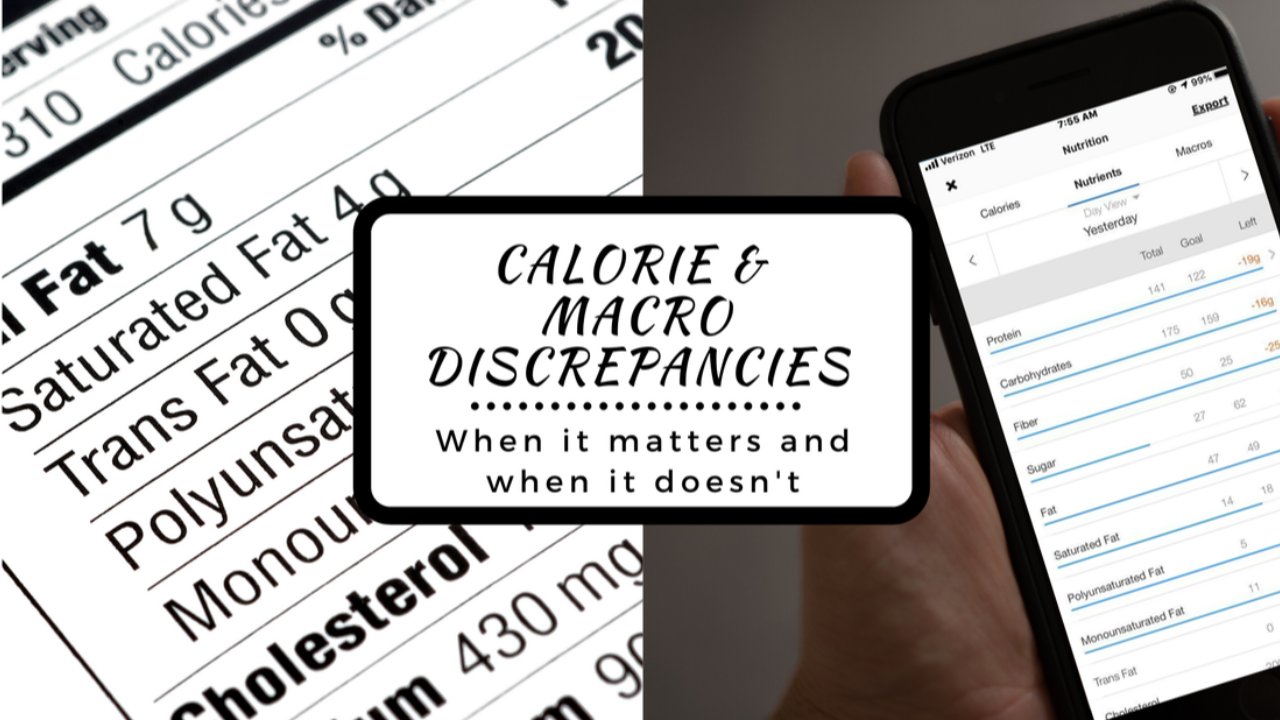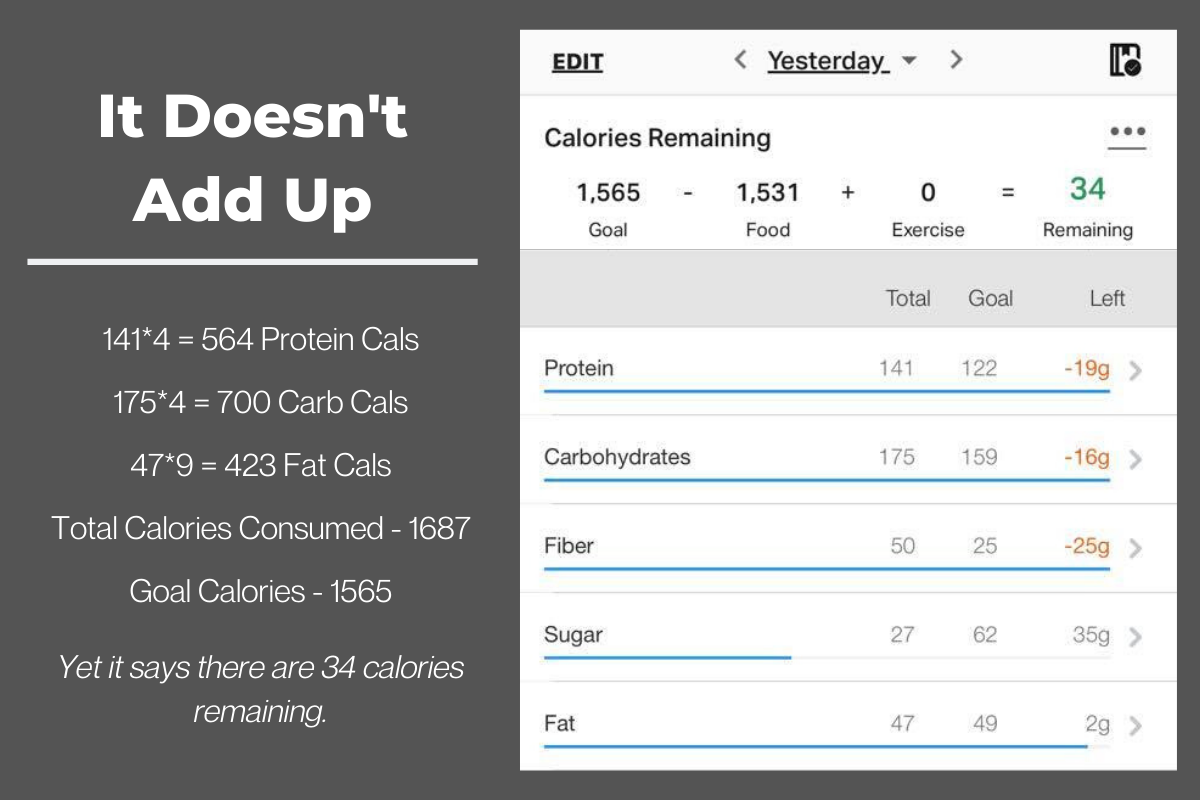Calorie and Macro Discrepancies
May 12, 2023
My clients and members of my private Facebook Group, Macro Counting 101, are constantly asking about the discrepancies that they see when they are tracking their food intake.
This goes for trying to choose the proper food item to log and seeing a wide variety of calories and macros for the same 100 grams of raw chicken breast.
It also happens on the back end when you are reviewing your daily log and all of a sudden you have 20 grams of protein left to eat but you have already reached your calorie goal. Or you hit all of your macros but your calories are either under or over.
What do you do in these cases? Should you worry about the discrepancies? Are you just playing a big calorie/macro guessing game? Does this even work? Is it worth the stress of figuring it out? I certainly don't stress over eating pizza and ice cream maybe I should just go back to doing that.
Ever have that inner dialogue go on in your head? Yeah I have too! So let's chat about what you can do about it.
Picking the right food item
Let's start with how do you choose which 100 grams of chicken breast is the right one to log. To show you how crazy this stuff can be, here are few screenshots I took from My Fitness Pal with varying calorie and macro inputs for our chicken example.

Let's take a look at these and do some math and I'll point a couple things out.
Before we start, when you are searching for food items to log, make sure you also include whether you logging that item raw or cooked. To get even more specific if you are logging a cooked food, add the cooking method to your search. Grilled chicken, poached, pan fried, or deep fried will all have different nutritional values. That's one reason why weighing and tracking raw can be more accurate.
All of these images are showing different values for the same 100 grams of chicken. If you are new to using My Fitness Pal (MFP), you may see that green check mark on the first pic and think that that is a good sign. The green check mark means it is a "verified" food. It means that all the necessary information has been recorded, and that enough users have logged it so therefore it must be right. Unfortunately there are no magical macro elves double checking the calorie math on all of these. Just a reminder on that math if you are unaware;
1 Gram of Carbohydrate = 4 Calories
1 Gram of Protein = 4 Calories
1 Gram of Fat = 9 Calories
Let's do some math starting with image one, the verified item; 1 gram of fat = 9 calories + 31 grams of protein = 124 calories for a total of 133 calories. The calorie total states 110. Close but not quite!
Image #2; 1.6 grams of fat = 14.4 calories + 22.3 grams of protein = 89.2 calories for a total of 103.6 calories. That calorie total is 172. That's WAY OFF!!!
Image #3; 0.9 grams of fat = 8.1 calories + 22.8 grams of protein = 91.2 calories for a total of 99.3 calories. Not even close there either.
Now is probably the point where you say, "What the Hell", throw your arms up in the air and give up! Hang with me for a bit longer!
Here's one tip that I've found that will help you find more accurate information. Include "USDA" in your search of foods if it is "whole" food, meat, fruit, veggies, etc.
Let's do the math on this one; 2.6 grams of fat = 23.4 calories + 21.2 grams of protein = 84.8 calories for a total of 108.2 calories. It's still 6 calories off!
Is that close enough, yeah probably, and I'll explain that later.

So here are my tips to make sure you are logging the correct food.
- With whole foods try adding "usda" to your search
- Do some quick calorie math, especially for a food that you item regularly. This way it will show up in your MY FOODS tab in MFP and you can go to it with confidence after that first time searching for it.
- Look for Green Check Marks, but don't trust them blindly. There's a better chance that they are accurate but as we saw above, it's not a guarantee.
- Add the cooking method to your search or measure everything raw.
- Don't trust the bar code scanner, double check the math on these items too. If the first person that scanned an item and added it to the MFP food database entered the information incorrectly, that bad information is going to be attached to that barcode.
- If things don't seem right cross reference the data in your tracking app with a website like the USDA Food Information and Nutrition Center
- If all else fails, create your own food item. You can do this by hitting the "+" sign in the top right of MFP when you are searching for a food, than click "Create a Food". If you are frustrated with food items being wrong, make sure you fill this out completely and accurately, do the math and make sure it is right. Someone down the road will thank you for doing it right.
Let's go back to that 6 calorie difference even in the USDA log, does it matter? Like my answer to a lot of things in the nutrition space, "Kind of, but not really."
What I mean by that is yeah if every food item is off by a little bit then there is a chance your numbers at the end of the day/week will be wildly inaccurate. So yeah you should be diligent about tracking accurately and finding food items that are accurate and aren't wildly off like some of the ones we saw in the chicken example.
At some point though, you have to be willing to say it doesn't really matter. That point is going to look wildly different depending on your goals. Are you aiming to be Mr. or Ms. Olympia or are you just trying to lose 10 pounds and have your clothes fit better? For the mom or dad looking to lose a little fluff, the stress of getting crazy precise likely won't be worth it.
Let's look at it a different way. You can burn 6 calories putting your dishes in the dishwasher! Speaking of the dishwasher, did you lick every tiny speck of food off that plate, if not then your numbers are going to be off... I say that jokingly I hope you know. Plus one day you might make 10 trips to the dishwasher and the next day you take 8, that will affect your total calorie burn.
It just goes to show that in the process of tracking things and how much you burn daily through activity and exercise will be off in both directions. Our goal should be to get close enough where things balance out in the long run.
I hope that helps you understand a bit more about how to track more accurately and how the process of tracking and finding the right food items.
Troubleshooting mismatched calories and macros
The other thing that I often get questions about in regards to discrepancies, is at the end of the day when a person logs all their food and now all of sudden calories and macros don't match up like they should. There's not a week that goes by that someone doesn't post a graphic like the one below asking why these things don't match up.

This happens A LOT! This is where you can likely apply Occam's Razor, the simplest explanation is most likely the one causing the issue. In this case it is usually tied to a food input that got added incorrectly and logged. There are other possible issues. One being macros and calories are often rounded. I'm going to make a big assumption here but let's say this person logged 10 items where the protein grams each were 9.6 grams of protein. In MFP that would round up to 10 grams of protein consumed multiplied by 10 different times logging it for a total of 100 grams of protein. Calorie math would say that would be 400 calories worth of protein if you are looking at the total number. If you do calorie math based off of the 9.6, that only adds up to 384 calories, a difference in 16 calories.
Once again, 16 calories, not a huge deal but you combine something like this along with a few bad inputs and your numbers can show some discrepancies.
Another thing that I've seen happen frequently with this type of discrepancy is fiber numbers count towards carbohydrate grams but not towards calories. This isn't entirely accurate, yet allowed by the FDA and used by food manufacturers to determine calorie content. It's true that fiber doesn't get digested like a simple carbohydrate and likely doesn't contribute 4 calories per gram. It still contributes some energy through the fermentation of those fibers in the intestinal tract. When looking at the log above and seeing that this person consumed 50 grams of fiber, that is likely one aspect of this discrepancy.
Another thing I see causing issues like this is the increased use of sugar alcohols in food products. These are things like sorbitol, xylitol, and erythritol. They are used as sweeteners and their calorie content can vary from 2.6 calories per gram to basically nothing. They are required to be listed on food packaging as a carbohydrate. Like fiber it will be counted as a full gram of carbohydrate but will skew the total calorie amount in that item.
Lastly, alcohol will throw your numbers off. Most alcoholic beverage will get it's calories from a combination of the alcohol itself along with some carbohydrates. This will end up driving your calories to your goal amount before you reach all of your macro goals.
Hopefully you are little better informed on how to work your way through logging your food and also troubleshooting numbers after the fact. Will it ever be perfect? Likely not. If you are little OCD like me, this will require you to give up a little control and settle for good enough. As I alluded to earlier, that degree of good enough is going to vary significantly based on your goals.
Is tracking worth it? Is it possible to get close enough that you can still results?
Yeah, I think it is and yeah you can still have incredible success if your numbers aren't spot on. It takes a little bit of work up front, but it does get easier. You start learning how to log more accurately which then leads to you hitting your numbers on your macro plan more consistently, which then leads you to see results faster. As you see results, your confidence increases, and this cycle continues.
I've helped hundreds of people through my Macro Bootcamp work through that initial phase where things are a little more difficult and answer all their questions. Once through that program they leave with the confidence to continue to track effectively and efficiently.
Whether you jump into a Bootcamp or you learn the process on your own, know that there is a going to be period where it is a little hard and you will likely feel overwhelmed. I say that and everything in this post to basically say don't freak out and give up if things aren't perfect. Trust the process! You'll learn, it will get better and easier.

